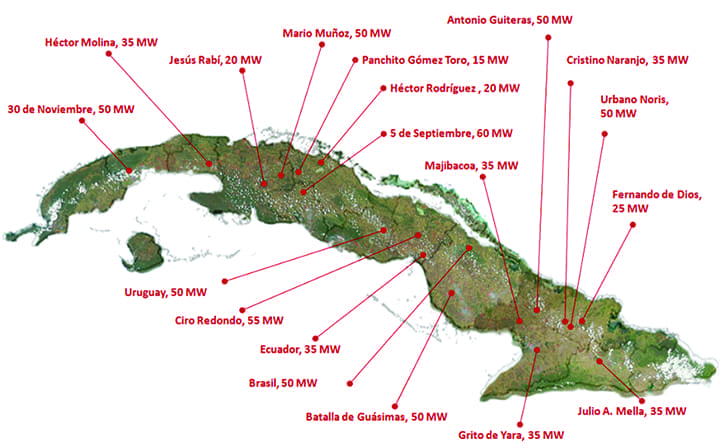Cuba's First Biomass-Fired Power Plant Inaugurated
The first biomass-fired power plant in Cuba—located adjacent to Ciro Redondo sugar mill in the central province of Ciego de Ávila—recently synchronized its two boilers to the grid. The 60-MW plant is expected to provide about 50% of the province’s power demand.
The first stone for the plant was symbolically placed in April 2017 by ambassadors from the UK and China. Construction began in March 2018. The original schedule projected commercial operation by November 2019, but Hurricane Irma delayed completion. The first boiler erected was tested for 72 hours in mid-January, generating about 1,550 MWh and consuming about 2,120 tons of marabou during the period. The unit was first synchronized to the national grid on March 16. The second boiler was synchronized to the grid on April 24. Currently, both boilers are operating satisfactorily, and the last work on road systems and administrative buildings is expected to be completed this year.
The plant will supply steam (about 122 tons/hour) and all the electricity needed by the sugar mill (about 8 MW), while the remnant power will be delivered to the national grid. The facility is capable of consuming about 2,100 tons of bagasse and 1,200 to 1,500 tons of marabou every day. It is expected to save about 100,000 barrels of oil per year and the emission of about 300 tons of carbon dioxide (CO2) annually.
The plant is expected to consume marabou biomass from June to November, and sugarcane bagasse from December to May, which will be supplied by the sugar mill along with condensate. This will eliminate the emanation of bagacillo, an organic byproduct generated in the surroundings of the sugar mill that affects the community neighboring the sugar plant.
The plant was erected at a cost of about $180 million from an association between the British company Havana Energy and the Cuban company Zerus, part of the Azcuba group, thus creating a mixed enterprise named BioPower S.A., which is assigned to administrate the plant. The Chinese company Shanghai Electric was designated for engineering, procurement, construction, and startup of the facility. The Chinese specialists will continue operating the plant along with Cuban personnel for two years, until the guarantee period expires, according to the signed contract.
About 325 Chinese specialists and technicians labored during the construction phases, while near 200 Cuban workers and 40 engineers of different specialty areas were involved in the task. This is the first time that Cuba has generated electricity from marabou biomass. There are plans to erect another 18 units adjacent to the same number of sugar mills across the country by 2030 (Figure 1), with a total capacity of 755 MW.
 |
|
1. The locations and sizes of biomass-fired power plants planned for construction in Cuba by 2030 are shown on this map adjacent to the sugar mill that will supply them with fuel. Courtesy: Cuban Ministry of Energy and Mines, and AZCUBA |
Currently, there are two units under construction in Cuba. One is near the Jesús Rabí sugar mill in Matanzas province (20 MW) and the other is adjacent to the Hector Rodríguez sugar factory in Villa Clara province (20 MW). A 50-MW facility is expected to start construction later this year next to the 30 de Noviembre sugar mill in Artemisa province.
The sugar industry produces its own fuel, which is considered renewable and environmentally friendly because CO2 generated from burning bagasse was originally absorbed by the sugar cane through the photosynthesis route during its growing period. Therefore, it does not increase the presence of the greenhouse gas in the atmosphere.
Cuba seeks to expand the use of renewables to reach about 24% of the national electric generation by 2030. About 14% is planned to come from biomass-fired facilities.
—Amaury Pérez Sánchez ([email protected]) is a chemical engineer based in Cuba with the University of Camagüey.